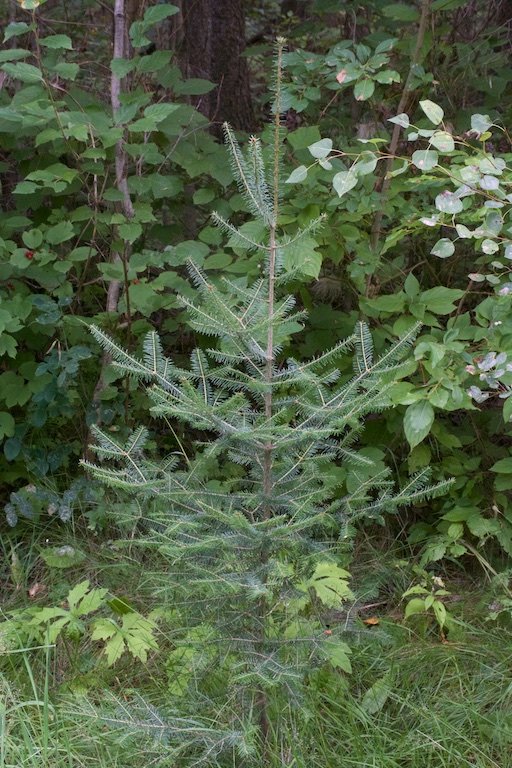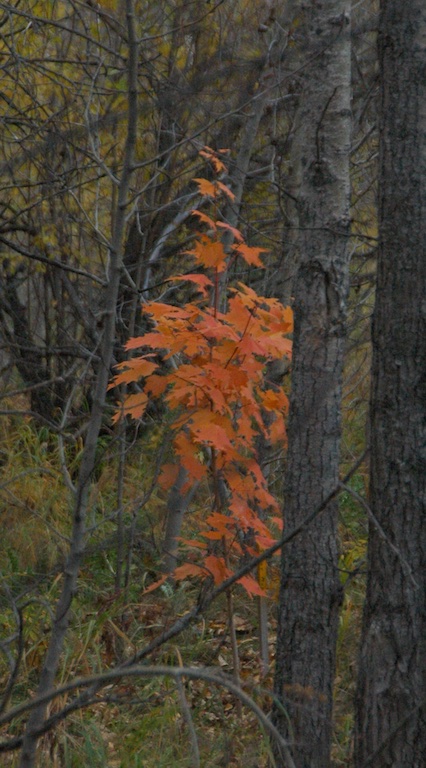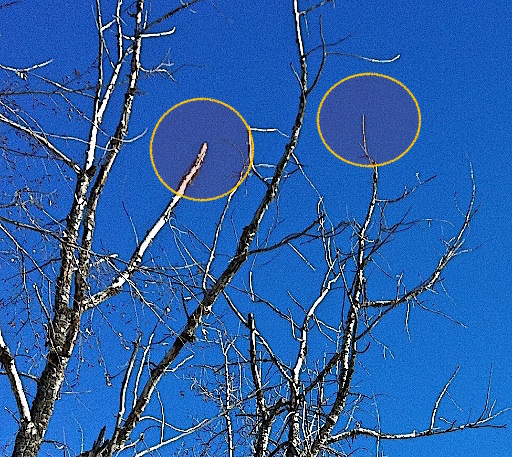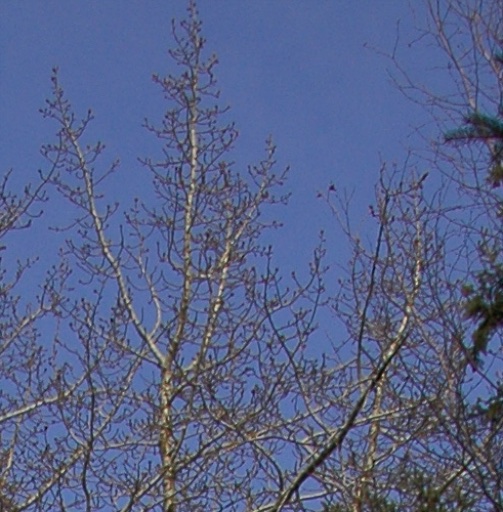
The key is to plant trees that tolerate shade. Balsam fir is one.

All of the maples are shade tolerant. This one has been here now for 6 years.

Look at the tops. Look for branches that have no twigs. Look for twigs that have no buds.

Compare to this shot. Twigs are regularly spaced on branches. Twigs have big fat buds on them.
Rejuvinating Poplar Bush
Keep your forest forever young
A while ago a customer sent me a picture of the cotoneaster hedge they had planted the year before. It was doing wonderfully. But in the background I saw that their poplar bush was dying. A good fifth of the trees were standing dead trunks. Many others had dead tops, or very few small twigs. Their poplars, and the ecosystem they host were dying.
Young poplar don't grow in the shade. A poplar forest expands at the edges and dies in the center, being gradually replaced by spruce. (For lots more detail about this process, see Our Forests)
Left to itself it tends to happen fairly quickly. But there are some strategies you can use to buy time, and make the transition or rejuvenation less ugly.
Do you have a problem?
How many dead trees? Dead tops? It's easiest to check during the dormant season, when the tops aren't obscured by leaves lower down. I think fall is the best time. I start when the trees are just starting to drop their leaves. I can see somewhat better, see which trees are dying, and can mark them for firewood. Second best is Leaf Day -- that day in spring when the poplar buds start opening. You can tell which twigs have leaves, but the leaves aren't big enough to block the view. Finally, any time in winter. A set of binoculars helps: You can check the twigs high up in the trees to see if they have buds.
Signs to look for
- Trunks with no branches.
- Tops with a lot fewer branches than other trees.
- Branches with no small twigs.
- Loose bark or bare sections of branches.
- Twigs with no buds. (Easy to see late winter.)
- Bench fungus and mushrooms growing on lower trunk.
- Lots of woodpecker sign: Cavities, chipped bark.
Actions
All is not lost. You can either replace the poplar with other kinds of trees, or you can create conditions that favour a surge of new poplars.
Micro Clear cuts
If you have a large hunk of bush -- dozens of acres -- you can cut clearings a several acres in size. This is large enough to provide sun for the young poplars. You've created edge for the poplar to grow into. Do 5-10% per year this way, If 10% makes for clearings that are too small, do larger ones every other year. Use the lower number if your poplar is overall just starting to die, use the larger if you are running on borrowed time.
Clearings should be a minimum of 4-6 times the height of the trees. Aspen are typically 50-60 feet tall at senility. Balsam poplar: 80-110. Smaller clearings than that don't get enough sun during the day. If you are working at the 2 acre end of clearing size, make them somewhat oval, long axis more or less north south. If you push the lower end of the size range, then make the clearings 1.5 times larger north-south than they are east-west. E.g. Aspen at 50 feet should have a clearing size of 300 feet x 300 feet minimum. You will get better results for that area if you make it 250 x 360, with the 360 dimension running north south. This will maximize summer sun.
Planned Succession
A quarter section of poplar bush would mean possibly 15 acres a year. This is less like a weekend project and more like a job. So don't do it all with micro-clearcuts.
Normally as poplars fall over spruce get started in the resulting spot. You don't have to wait. As you thin out the dead ones for firewood, plant a spruce tree on the north side of the stump. Cut the top of the stump at a slant so that the water flows toward the young tree. The stump gives the young tree some protection, some extra water, and some nutrients as the roots decompose. Other trees suitable for this include Balsam fir, High Bush Cranberry, Hawthorn, any of the maples, Eastern White Cedar, Eastern White Pine, Green Alder.
Expansion
The edges of a poplar bush are constantly senting out suckers. If you have room, let a band of them grow. Typically suckers come up 10-50 feet from the edge of the existing stand. Go ahead an mow on both sides of the band, leaving a 10 foot wide band with the highest density of new trees. Let them go until they are about 10 feet tall, then reduce their numbers to about 1 per square yard. Wait for the trunk to get to 2-3 inches, and reduce to 2-3 trees per 10 foot chunk of band. Cutting the numbers artificially gets the remaining ones larger sooner, and ready to take up the expansion.
Thinning
This buys you time. In their maturity they are having a hard time pumping water to the top of the tree, espcially at summer's end when the leaves are still transpiring full blast, but soil moisture is low. This is why the tops die first. The leftover leaves lower down can't make enough food to keep the tree going. By thinning out the forest, you leave more water for the remaining ones, and somewhat more light lower down. They are under less stress during the late summer and fall.
But you have to stretch this process. Take out too many trees at once, and the wind gets a better grip on the remaining ones, and you can lose a lot of trees in a big storm, make the remaining ones even more vulnerable. Take out a few at a time, and the remaining ones build stronger roots to hold against the wind force. Rule of thumb: Take out 10-15% per year for 2-3 years.
One way to do this is to make trails through the woods. This is not only useful for getting the firewood out, but it makes for pleasant walks, mountain biking, cross country skiing and snowmobiling. (Warning: Snowmobiles have much wider turning radii than do tractors pulling mowers.)
Reduce the Understory
The grass and shrubs below the trees are competing for water. Mowing some of this is one way to leave more water and nutrients for the poplars. This is a lot of work, and frankly not worth it. If done extensively it puts a pretty serious dent in the diversity in the forest floor. However, widening your existing trails can be an effective compromise.
Got something to say? Email me: sfinfo@sherwoods-forests.com
Interesting? Share this page.
Want to talk right now? Call me: (8 am to 8 pm only, please) 1-780-848-2548
Do not arrive unannounced. Phone for an appointment. Why? See Contact & Hours That same page gives our hours of operation.
Back to Top
Copyright © 2008 - 2021 S. G. Botsford
Sherwood's Forests is located about 75 km southwest of Edmonton, Alberta. Please refer to the map on our Contact page for directions.
